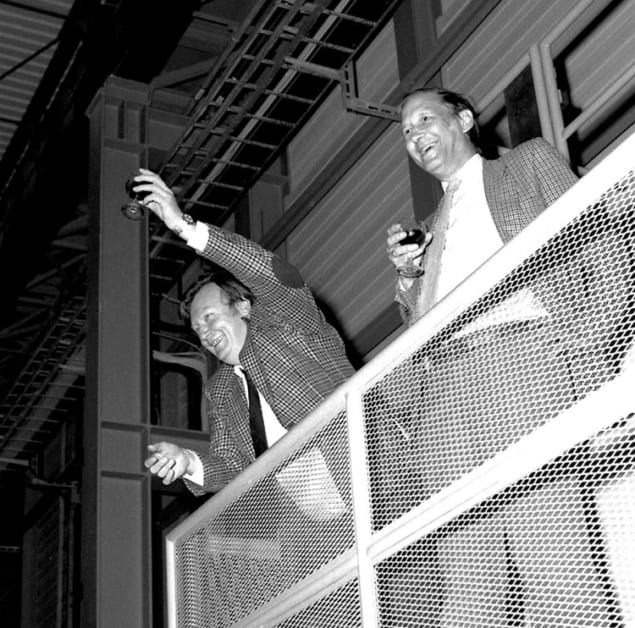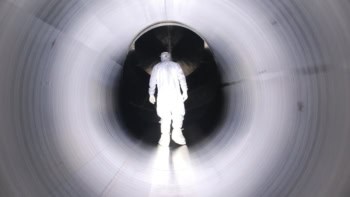
Simon van der Meer, who shared the 1984 Nobel Prize for Physics with Carlo Rubbia, died on 4 March at the age of 85. The pair were awarded the prize for their roles in discovering the W and Z bosons – the particles that carry the weak force – at the Super Proton Synchrotron (SPS) at the CERN particle-physics lab near Geneva. Van der Meer pioneered the technique of “stochastic cooling”, which helped to ensure that sufficient antiprotons entered the collider to allow W and Z to be discovered.
Van der Meer was born on 24 November 1925 in the Hague, the Netherlands, before going on to study technical physics at the University of Technology in Delft. Graduating in 1952, he then joined the Philips Research Laboratory in Eindhoven, developing high-voltage equipment and electroncis for electron microsocopes. He joined CERN in 1956, where he was to spend the rest of his career before retiring in 1990.
Working under the leadership of John Adams – a future CERN director-general – Van der Meer made his name in the early 1960s developing a device known as a “horn” that could increase the intensity of neutrino beams. These devices are still used today as they allow focused beams of neutrinos to be sent through the Earth for hundreds of kilometres to huge, ultrasensitive underground detectors. Van der Meer then worked on an experiment at CERN for measuring the anomalous magnetic moment of the muon, which taught him the principles of accelerator design.
In 1967 Van der Meer started developing magnet power supplies for CERN’s accelerators, including the SPS and the Intersecting Storage Rings (ISR). It was while working on the ISR that Van der Meer developed the idea of stochastic cooling to increase the intensity of the collider’s proton beams. Although the technique was not used on the ISR, it was put to the test on the Initial Cooling Experiment, persuading Rubbia and others in 1976 to deploy it on the SPS. Van der Meer subsequently joined the SPS, where he helped to lead the Antiproton Accumulator project, which used stochastic cooling to accumulate enough antiprotrons for the collider.
The technique uses sensitive electrodes to pick up small “stochastic” electromagnetic signals that register that the average condition of a particle beam, such as its density. These stochastic signals – and hence the properties of the beam itself – can then be controlled using a high-frequency “kicker” that sends out rapidly varying electric and magnetic fields. The technique can therefore shrink the size of a beam in all three spatial dimensions, thereby boosting the collision rate. The beam is said to have been “cooled” because the particles occupy a smaller volume, just as gas molecules would in a cooled balloon.
Researchers at the SPS eventually discovered the W and Z bosons in an experimental run that began in late 1982 and continued into January 1983. Van der Meer also proposed a method known as “stochastic extraction” that was used at CERN on the Low-Energy Antiproton Ring (LEAR) and on its successor machine – the Antiproton Decelerator (AD). Physicists working in the ASACUSA collaboration recently used the AD to create a beam of antihydrogen atoms that is suitable for spectroscopic studies, for which the team shared the 2010 Physics World Breakthrough of the Year.
In a statement, current CERN boss Rolf-Dieter Heuer and the lab’s director of accelerators Steve Myers described Van der Meer as “a true giant of modern particle physics, though a gentle one [whose] contributions to accelerator science remain vital for the operation of accelerators such as the LHC today”. He was, they say, “an incredibly inventive man [who] when confronted with a problem would sink into deep reflection, rarely emerging until he had a solution”, adding that “stochastic cooling was typical of a Simon van der Meer invention: deceptively simple at first sight, but to anyone who truly understands accelerators it was nothing less than a stroke of genius”.
Speaking to physicsworld.com, Rubbia paid tribute to Van der Meer, calling him “one of the most extraordinary people” he had ever met. “He was able to make everybody feel at ease by the clarity of his thinking and his enormous kindness,” Rubbia added. “His ideas were extremely original and he was able to make everyone understand them.”
Rubbia first worked with Van der Meer at the CERN Proton Synchrotron (PS) where he invented the neutrino horn. “We were then together at the ISR, where he developed a very ingenious way to determine the beam luminosity and invented stochastic cooling, which has become a tremendous opportunity for proton–antiproton collisions. Comparable to his great competence was his legendary modesty. It has been a great honour for me to share the Nobel prize with him.”



